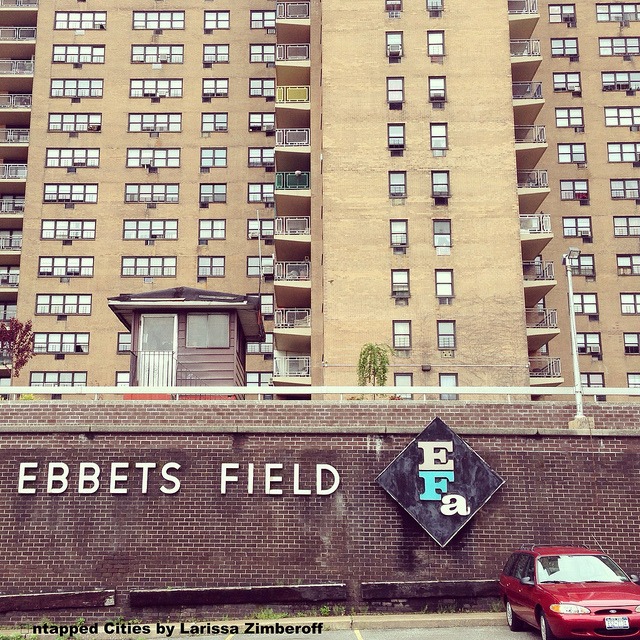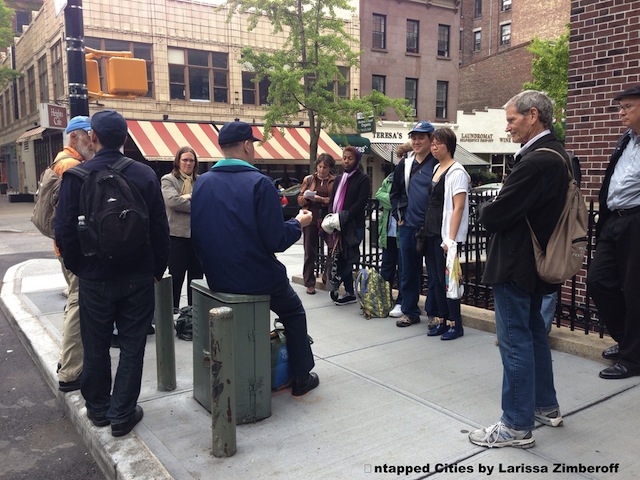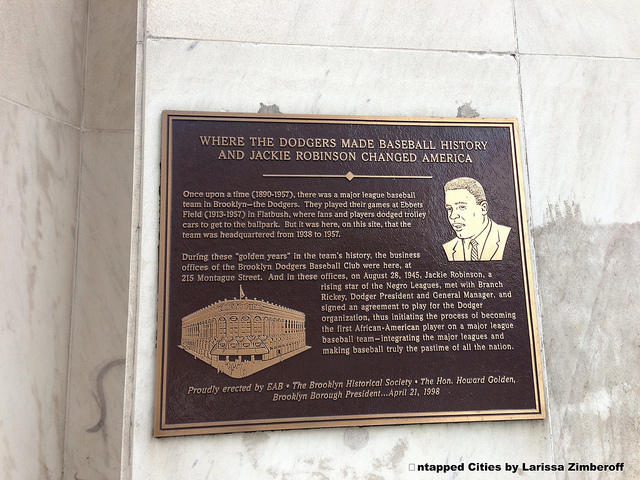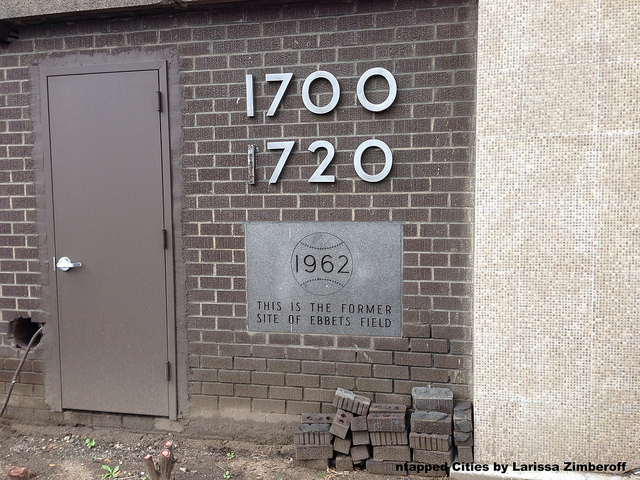
Nearly one third of all World Series baseball games have been played in New York City. Twenty-eight of those games were played in the confines of tiny Ebbet’s Field (4.5 acres in size compared to Yankee stadium’s 11), formerly in Flatbush, and once home to the Brooklyn Dodgers. No longer a dollhouse-sized ballpark, the historic park was replaced by towering brick apartment buildings, and is now an area referred to by realtors as Crown Heights.
The Municipal Art Society tour of Jackie Robinson’s Brooklyn began along the waterfront, in Brooklyn Heights, facing the Manhattan skyline. As we looked across the East River at the Wall Street beacons, we glanced over at our equally towering tour guide, Peter Laskowich, in navy khakis, heavy thick soled black oxfords, and a blue hat with an NY logo. With copious notes, on striped yellow legal paper, held close in his right hand, Peter started us deep into the story of Robinson and the Dodgers: “The Dodgers are not welcome back in New York,” he said. “They left, so we hate their guts.” His words may have felt like the hazing those scrappy Dodgers experienced while they lived in the shadow of the “big city.”
 Peter, our Municipal Art Society tour guide, recounting just some of the Brooklyn Dodgers history.
Peter, our Municipal Art Society tour guide, recounting just some of the Brooklyn Dodgers history.
In a voice worthy of a pulpit or a stage, Peter pointed at the East River in order to express the short distance but wide separation that was felt between Manhattan and the tiny eastern borough. With little time to spare, our long-legged tour guide was off. At Montague and Hicks Street, named for a large Dutch farming family in Brooklyn, Peter shared with us a little historical slur, suggesting that the saying that someone is from “the hicks” is derived from this very location, and in reference to the somewhat rough-around-the-edges Brooklynites. This tied in well when we also learned that the Dodgers’ name comes from the remark that someone (in Brooklyn) is dodging the fare box on the trolley.
The man credited for putting the borough on the map, in baseball at least, was Branch Rickey, a man with a deep faith in both the Church and baseball. In 1942 Rickey, then the General Manager for the Brooklyn Dodgers, began looking for a player that could take the team to glory. He drew up a short list of players he had scouted from the Negro leagues, and Jackie Robinson was on that list. Robinson was a faster runner and better at basketball than baseball, but he turned out to be just the right person to challenge the rules of the game.
From Hicks Street we moved on to the Bossert Hotel, once a flashy residence, which was host to the team’s single World Series championship party, in 1955, over the Bronx Bombers (aka the New York Yankees).
 Plaque on a Brooklyn building commemorating Jackie Robinson’s place in history.
Plaque on a Brooklyn building commemorating Jackie Robinson’s place in history.
Our stop was brief and we quickly walked to a building a few blocks away, at the corner of Court and Montague Street. As we leaned against a building that replaced the original building, we learned of a secret meeting in 1947 amongst the ballpark owners to vote on whether or not minorities should be allowed to play the game. The vote came back 15 to 1 against it. But Branch Rickey, the Dodgers GM, didn’t care. Before the nation was ready for integration, Brooklyn threw Robinson into their game. His first major league game was played on April 15, 1947.
Back in the present day, Peter promptly told everyone to get their Metro cards out and he was off at a brisk clip. Our next stop was Crown Heights. As the 2-train rocked its way southeast, to the original location of Ebbet’s Field, a few people asked what we would actually be seeing when we arrived at the site. Peter took the time to regale us with more baseball history.
 A plaque commemorating the former location of Ebbet’s Field, where the Brooklyn Dodger’s played through the 1957 season.
A plaque commemorating the former location of Ebbet’s Field, where the Brooklyn Dodger’s played through the 1957 season.
Once in Crown Heights, the group made the somewhat long walk over to the location of the original ballpark. Peter pointed out how long the walk was, and how far the subway was from the stadium. We then walked the circumference of the apartment complex, our guide noting when we were passing center field, the pitcher’s mound, and the dugout. Charles Ebbet, the man who paid the bill for Ebbet’s Field, actually ran out of money and couldn’t make it as large as he wanted.
There are a few signposts to notice along the way: a children’s park, a mural, a bronze placard, but the memories of baseball are best brought to life with a guide like Peter. Still wincing from the pain of the team’s departure to the west coast, Peter will undoubtedly share a few things with you that you never knew.
Check out the Municipal Art Society schedule for future history buff worthy walkabouts.





